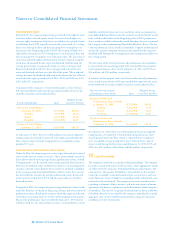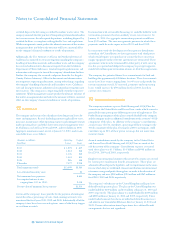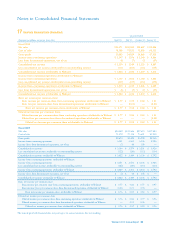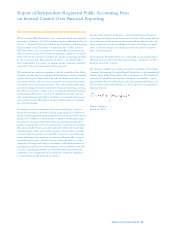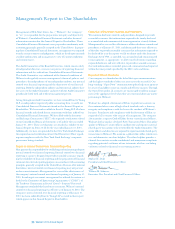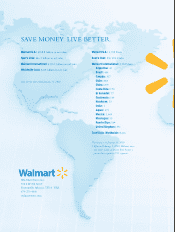Walmart 2010 Annual Report Download - page 52
Download and view the complete annual report
Please find page 52 of the 2010 Walmart annual report below. You can navigate through the pages in the report by either clicking on the pages listed below, or by using the keyword search tool below to find specific information within the annual report.
15 Restructuring Charges
In the fourth quarter of fiscal 2010, the company announced several
organizational changes, including the closure of 10 Sam’s Clubs, designed
to strengthen and streamline our operations. As a result, we recorded
$260 million in pre-tax restructuring charges as follows:
Fiscal Year Ended January 31, 2010
Asset
(Amounts in millions) Impairment Severance Total
Walmart U.S. $ — $ 73 $ 73
Sam’s Club 133 41 174
Other — 13 13
Total $133 $127 $260
The asset impairment charges generally relate to the real estate of the
Sam’s Club closures, which were written down to their estimated fair
value of $46 million. The fair value was determined based on comparable
market values of similar properties or on a rental income approach, using
Level 2 inputs of the three-tier fair value hierarchy.
The total pre-tax restructuring charge of $260 million is classified in
operating, selling, general and administrative expenses on the accom-
panying Consolidated Statements of Income. At January 31, 2010, we
had $127 million of severance included in accrued liabilities on the
accompanying Consolidated Balance Sheets, the majority of which is
expected to be paid by the first quarter of fiscal 2011.
16 Recent Accounting Pronouncements
The company adopts new accounting policies or adjusts existing accounting
policies to comply with new accounting standards promulgated by the
Financial Accounting Standards Board (“FASB”) or the SEC. The follow-
ing subcaptions provide a discussion of the company’s adoption of new
accounting policies as required by new accounting standards that became
effective February 1, 2009 or will become effective in future periods.
Accounting for Acquisitions
The company accounts for all consolidated acquisitions and business
combinations using the purchase method of accounting. As a result
of new accounting standards effective February 1, 2009, the company
changed some of its accounting for business combinations on February 1,
2009. Therefore, certain accounting policies differ when accounting for
acquisitions occurring before and after February 1, 2009, as discussed below.
The company applied the following policies in accounting for business
combinations that occurred prior to February 1, 2009:
• acquisition costs were included as part of the purchase price;
• purchase accounting was applied to only the company’s proportionate
share in the fair value of assets and liabilities acquired in a partial
acquisition (less than 100% control was acquired);
• goodwill was recorded only to the extent of the company’s proportionate
share in a partial acquired entity;
• contingent consideration, if any, is recorded as additional purchase
price when settled;
• adjustments to income tax valuation allowances or uncertain tax
positions are recognized as adjustments to the accounting for the
business combination; and
• contingent liabilities acquired were recorded at acquisition if probable
and reasonably estimable.
Subsequent to February 1, 2009, the company applies the following
policies in accounting for business combinations, when applicable:
• costs related to an acquisition are expensed as incurred;
• regardless of the level of ownership acquired, the company records
the full fair value of all assets and liabilities acquired as part of the
purchase price allocation;
• goodwill includes any noncontrolling interest portion and is recorded
as the excess of the cost of the acquisition over the total fair value of
all assets and liabilities acquired and any noncontrolling interest;
• contingent consideration, if any, is included at fair value as part of
the initial purchase price;
• adjustments to income tax valuation allowances or uncertain tax
positions after the acquisition date are generally recognized as
income tax expense; and
• contingent liabilities acquired are recorded at fair value. If fair value is
not determinable, a reasonably estimable amount is recorded, provided
the incurrence of the liability is probable.
No acquisitions have occurred subsequent to February 1, 2009. However,
if any adjustments to income tax valuation allowances and uncertain tax
positions that relate to acquisitions prior to February 1, 2009 occur within
a one-year period from the acquisition date due to revised facts and
circumstances that existed at the acquisition date, then the adjustment
will be recorded to goodwill. Adjustments outside the one-year mea-
surement period are typically recorded to income tax expense.
Noncontrolling Interests
Effective February 1, 2009, the company generally reports noncontrolling
interests in subsidiaries in the equity section of the company’s balance
sheet, rather than in a mezzanine section of the balance sheet between
liabilities and equity. Consolidated net income is also reduced by the
amount attributable to the noncontrolling interest to arrive at net income
attributable to Walmart. Accordingly, the changes have been retroactively
applied in the company’s Consolidated Financial Statements. Further-
more, when the company acquires some or all of the noncontrolling
interest, the transaction is accounted for as an equity transaction and
any amount paid in excess of the noncontrolling interest’s cost basis
acquired is recorded to additional paid-in capital.
All noncontrolling interests where the company may be required to
repurchase a portion of the noncontrolling interest under a put option
or other contractual redemption requirement are presented in the
mezzanine section of the balance sheet between liabilities and equity,
as redeemable noncontrolling interest.
Future Accounting Policy Adoptions
A new accounting standard, effective for the first annual reporting period
beginning after November 15, 2009 and for interim periods within that
first annual reporting period, changes the approach to determining the
primary beneficiary of a variable interest entity (“VIE”) and requires
companies to more frequently assess whether they must consolidate
VIEs. The company adopted this new standard on February 1, 2010.
We do not expect the adoption of this new standard to have a material
impact on our Consolidated Financial Statements.
Notes to Consolidated Financial Statements
50 Walmart 2010 Annual Report








